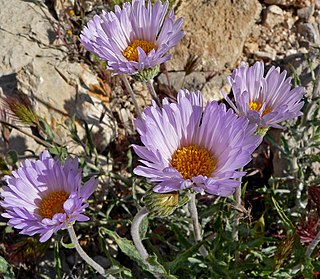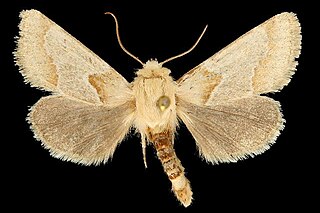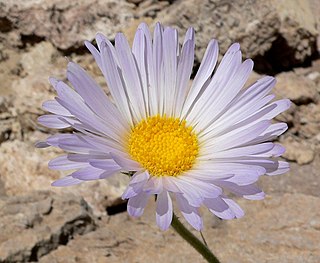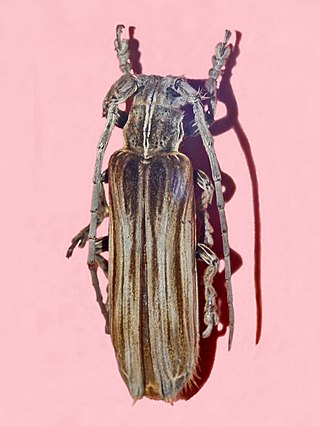
Astereae is a tribe of plants in the family Asteraceae that includes annuals, biennials, perennials, subshrubs, shrubs, and trees. They are found primarily in temperate regions of the world. Plants within the tribe are present nearly worldwide divided into over 250 genera and more than 3,100 species, making it the second-largest tribe in the family behind Senecioneae.

Townsendia is a genus of North American plants in the tribe Astereae within the family Asteraceae.

Xylorhiza is a genus of flowering plants in the family Asteraceae, known as woodyasters. These are daisylike wildflowers usually having blue to purple or white ray flowers with yellow centers of disc florets. Woodyasters are native to western North America.

Schinia ligeae is a moth of the family Noctuidae. It is found in North America, including Arizona, California, Nevada and Utah.
Schinia jaegeri is a moth of the family Noctuidae. It is found in southern California and northern Baja California.

Xylorhiza cognata is a rare species of flowering plant in the family Asteraceae known by the common names Mecca-aster and Mecca woodyaster.

Xylorhiza orcuttii is a perennial plant in the family Asteraceae known by the common name Orcutt's aster. It is native to southern California and northern Baja California, where it grows in scrubby habitat in the dry canyons of the Sonoran Desert. It often grows in rocky and sandy substrates, clay, and alkaline soils amongst cactus. It is a shrub with branching, mostly hairless stems that may reach 1.5 meters in length. The leaves are lance-shaped to oblong with smooth, toothed, or spiny edges. The inflorescence is a solitary flower head with up to 40 or more lavender or pale blue ray florets, each of which may measure over 3 centimeters in length. Flowering may begin as early as late fall or winter. The fruit is an achene which may be over a centimeter long, including its pappus of bristles.

Xylorhiza tortifolia is a species of flowering plant in the family Asteraceae, known by the common names Mojave-aster and Mojave woodyaster.
Tetracha pilosipennis is a species of tiger beetle that was described by Mandl in 1958.
Cymindis pilosipennis is a species of ground beetle in the subfamily Harpalinae. It was described by Escalera in 1922.
Trechus pilosipennis is a species of ground beetle in the subfamily Trechinae. It was described by René Jeannel in 1954.
Calathus pilosipennis is a species of ground beetle from the Platyninae subfamily that is endemic to the Canary Islands.

Xylorhiza is a genus of beetles in the longhorn beetle family (Cerambycidae).

Xylorhiza adusta is a species of beetles in the longhorn beetle family (Cerambycidae).
Xylorhiza cronquistii, common name Cronquist's woody-aster, is a plant species endemic to the Kaiparowits Plateau in Grand Staircase–Escalante National Monument in Kane County, Utah at elevations of 1900–2100 m.

Xylorhizini is a tribe of longhorn beetles of the subfamily Lamiinae. It was described by Lacordaire in 1872.

Pterolophia pilosipennis is a species of beetle in the family Cerambycidae. It was described by Stephan von Breuning in 1943. Pterolophia pilosipennis is 8.5 millimeters (0.3 in) in length.
Cymatura spumans is a species of beetle in the family Cerambycidae. It was described by Félix Édouard Guérin-Méneville in 1847, originally under the genus Xylorhiza. It has a wide distribution in Africa.
Xylorhiza dohrnii is a species of beetle in the family Cerambycidae. It was described by Lansberge in 1880. It is known from Indonesia.
Dr. Lucinda A. McDade is an American botanist and plant collector who is noted for her study of Acanthaceae and her work in conservation biology. She received her B.S. in Biology from Newcomb College of Tulane University, and her Ph.D. in Botany/Zoology from Duke University.









